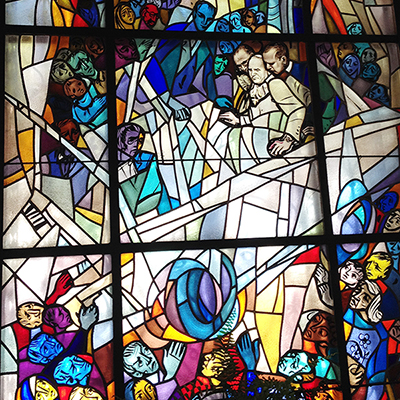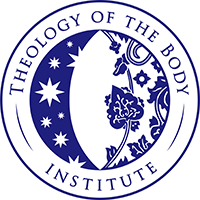

Poland, Fatima and the Blood of John Paul II
Poland, Fatima and the Blood of John Paul II

PART ONE
In August 2015, I led an amazing pilgrimage to Poland. Nearly 40 pilgrims and I were following in the footsteps of Saints Faustina, Maximillian Kolbe and, especially, John Paul II, visiting the many places of importance to their lives and the various shrines, centers, and museums that commemorate them. I had begun the journey by sharing with the pilgrims the connection between John Paul II’s Theology of the Body (TOB) and pilgrimage itself: TOB teaches us how physical realities communicate spiritual realities, and that’s what happens on a pilgrimage – the physical realities we encounter can be the occasion of profound spiritual experiences.
I simply was not prepared, however, for the experience I would have later in the week when I unexpectedly encountered a relic of great significance to John Paul II’s life, and to my own. Seeing this astounding piece of history with my own eyes was utterly overwhelming. No words can do it justice, but I’ll try nonetheless to paint the picture for you in this blog post and the next.
On the bus throughout the week, I had been sharing with the pilgrims the connection between the “secrets of Fatima” and John Paul II’s Theology of the Body. As most Catholics know, between May 13 and October 13, 1917, Mary appeared to three peasant children in Fatima, Portugal delivering a three-part message – the “three secrets” of Fatima, as they’ve come to be known. The first secret presented a horrifying vision of hell. The second involved a prophecy of World War II and the warning that “Russia would spread her errors throughout the world.” However, Mary assured the children, “In the end, my Immaculate Heart will triumph.”
Mary also told the children that “the Holy Father will have much to suffer.” This brings us to the “third secret” of Fatima, which was not publicly revealed until the year 2000. In 1917, the children saw a vision of bullets and arrows fired at “a bishop dressed in white.” Sixty-four years later, while driving through the crowd in St. Peter’s Square, a “bishop dressed in white” was gunned down by Turkish assassin Ali Agca … on the memorial of Our Lady of Fatima: May 13, 1981.
Many years later John Paul II reflected: “Agca knew how to shoot, and he certainly shot to kill. Yet it was as if someone was guiding and deflecting that bullet.” That “someone,” John Paul believed, was the Woman of Fatima. “Could I forget that the event in St. Peter’s Square took place on the day and at the hour when the first appearance of the Mother of Christ … has been remembered … at Fatima in Portugal? For in everything that happened to me on that very day, I felt that extraordinary motherly protection and care, which turned out to be stronger than the deadly bullet” (Memory and Identity, pp. 159, 163).
The fact that John Paul was shot on the memorial of Fatima is well known. What few people know is that the Pope was planning to announce the establishment of his Institute for Studies on Marriage and Family on that fateful afternoon. This was to be his main arm for disseminating his teaching on man, woman, marriage, and sexual love around the globe. Could it be that there were forces at work that didn’t want John Paul II’s teaching to spread? (In fact, by May 13, 1981, John Paul II was only about half way through delivering the 129 addresses of his TOB. Had he died, obviously, the full teaching never would have been presented.) And could it be that, by saving his life, the Woman of Fatima was pointing to the importance of his teaching reaching the world?
It would be over a year later that John Paul officially established his Institute (of which I’m a proud graduate). On that day, Oct. 7, 1982 – not coincidentally the Feast of Our Lady of the Rosary – John Paul II entrusted his Pontifical Institute for Studies on Marriage and Family to the care and protection of Our Lady of Fatima. By doing so, he himself was drawing a connection, at least indirectly, between his miraculous survival and the importance of the Theology of the Body.
As I shared with the pilgrims, digging deeper, the precise link, I believe, between John Paul II’s TOB and Fatima lies in Mary’s mysterious words about the “errors of Russia” and the promised triumph of her Immaculate Heart. John Paul II’s TOB is like weed-killer sprayed on the deepest roots of the “errors of Russia.” As such, I believe the TOB plays a critical role in preparing our hearts for her triumph.
PART TWO
Joy and pain, thorns and roses, intertwine in our lives. May the Blessed Virgin Mary teach us to turn this lot – which often leads us to the foot of the Cross, along with her – into our merit.”
That is an excerpt from the address Pope John Paul II had prepared for May 13, 1981. The pope’s secretary was holding the text when gunshots echoed throughout Saint Peter’s Square and a bloodied victim fell in his arms.
May 13, 1981, was not only the annual memorial of Our Lady of Fatima, it was also the day the Pope had planned to establish his Institute for Studies on Marriage and Family, his main arm for disseminating the TOB. Could it be that there were forces at work that did not want John Paul II’s teaching to spread?
Part of Mary’s message in Fatima was that “Russia would spread her errors throughout the world.” However, “In the end,” she said, “my Immaculate Heart will triumph.” When we hear of the errors of Russia, we rightly think of the spread of Communism. But Communism has roots that go deeper than our typical understanding of Marxist economic theory.
As most of us learned in school, Marx considered class struggle to be the defining factor of history. But what many don’t know is that Marx believed the fundamental “class struggle” was found in monogamous marriage and, indeed, in the sexual difference itself. “The first division of labor,” Marx co-wrote with Frederick Engels, “is that between man and woman for the propagation of children.” In turn, Engels affirmed that Marxist theory “demands the abolition of the monogamous family as the economic unit of society” (see The Origin of the Family, Private Property, and the State).
It seems the deeper revolution – and, I would contend, the deeper “error of Russia” – is the one aimed at destroying marriage and the family. Indeed, those who seek to deconstruct sexuality in the modern world often draw straight from Marx. As feminist author Shulamith Firestone wrote in The Dialectic of Sex: “[J]ust as the end goal of socialist revolution was … the elimination of the … economic class distinction itself, so the end goal of feminist revolution must be … the elimination of … the sex distinction itself [so that] genital differences between human beings would no longer matter culturally.” Welcome to the deep-seated sexual confusion in which we’re now immersed.
But here’s the good news: Just as John Paul II’s vision of the human person inaugurated a new kind of revolution that led to the fall of Communism, his TOB has also inaugurated a new kind of revolution that will eventually lead, I believe, to the collapse of the dominant sexual ideology.
In his book The Last Secret of Fatima, Cardinal Bertone wrote: “The Communist system seemed invincible, and it looked as if it were going to endure for centuries. But then the whole thing collapsed like a house of cards.” Perhaps we can expect the same with the deeper “error of Russia.” Indeed, in the Book of Revelation, the “whore of Babylon” – that mysterious feminine figure who mocks the Bride of the Lamb – is brought to ruin in “one hour.” And as she collapses, all the merchants who “gained their wealth from her” (think the porn industry, sex trafficking, Planned Parenthood, etc.) “weep and mourn” (Rev 18).
And then comes the triumph of the New Jerusalem, the Bride who has “made herself ready” for her Bridegroom. She is dressed in “fine linen, bright and immaculate” (Rev 19:7-8). She is “clothed with the sun” (Rev 12:1). This radiant Bride, of course, is personified in Mary. “In the end, my Immaculate Heart will triumph.” What does this mean? In short, it means that purity of heart will triumph. Somehow the pornographic lies will be redeemed. All of “Babylon’s” distortions will be untwisted and we will come to see the human body as it really is – as a glorious sign of “the mystery hidden from eternity in God” (TOB 19:4). In other words, the life God intended for our bodies will be restored! (When, we don’t know. How, we don’t know. But that it will happen we do know, for it is God’s promise.)
The victory, however, comes only at the price of blood: “For the life of the body is in the blood; and I have given it for you upon the altar to make atonement for your souls” (Lev 17:11). The Vicar of Christ, Saint John Paul II, gave his blood for us in Saint Peter’s square. I have been fascinated with that blood since the day he shed it, which I remember well. Over the years I have studied whatever I could get my hands on regarding the mystery of that fateful day and I have always sensed that graces in my life are intimately tied to that blood. Hence, you can imagine my utter astonishment when, totally unexpectedly, I encountered this (first and second class) relic at the newly established John Paul II Center outside Krakow…
Red and white: the colors of the Polish flag, the “Christ of nations.” Red and white: the colors of mercy presented to Saint Faustina as signs of the blood and water that gushed from the side of Christ. Red and white: the colors of the crowns presented to Saint Maximilian Kolbe as signs of martyrdom and purity. Red and white: the colors of the blood-stained papal cassock worn by Saint John Paul II on May 13, 1981.
I wasn’t just leading a pilgrimage to Poland, I was a pilgrim myself and my pilgrimage unexpectedly led me here, to this astounding relic. This was no longer something I was reading about in a book. It was before my very eyes. As pilgrimage is meant to do, the physical reality opened me up to deep spiritual mysteries. I prostrated myself and wept. And I prayed for the triumph of the Immaculate Heart – in my own life, and the life of the world.
It may be closer than we realize. Already in 1994, John Paul wrote that Mary’s words spoken in Fatima “seem to be close to their fulfillment” (Crossing the Threshold of Hope, p. 221). Let it be, Lord, according to your word. Amen.



